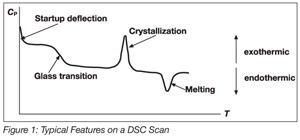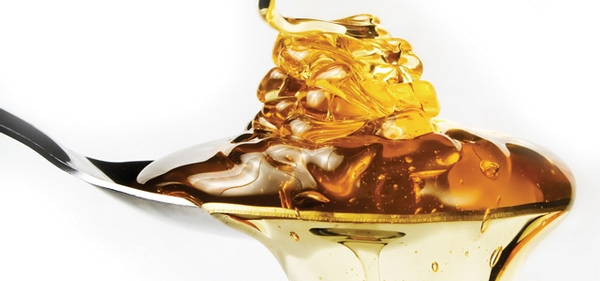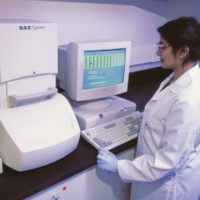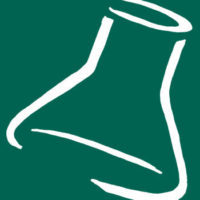Honey is defined as a naturally sweet mixture produced by bees (Apis mellifera) from the nectar of flowers, from secretions of parts of the living plants or excretions of plant-sucking insects on the living part of plants that the honey bees collect, transform and combine with specific substances of their own (such as enzymes), deposit, dehydrate, store and leave in the beeswax honeycombs to ripen and mature. Physically, honey is a viscous material, where all the sugars (33.3–43.0% fructose, 25.2–35.3% glucose, 0–2% sucrose, maltose as well as more complex sugars and trace polysaccharides) are present in an amorphous, devitrified state.
All components (carbohy-drates, water, enzymes, amino acids, pigments, variable amounts of sugar-tolerant yeasts, pollen, traces of vitamins, organic acids and wax and probably crystals of dextrose hydrate) are due to maturation of the honey; some are added by the bees, and some are derived from the plants. However, honey from the same floral source can also vary due to seasonal climatic variations or to a different geographic origin.
Aside from the definition of honey in the Codex Alimentarius (1981), there are additional definitions in the regulations of many countries and the European Union (EU). Various physical types (pressed, centrifuged and drained) and forms (comb, chunk, crystallized or granulated, creamed and heat-processed) of honey are on the market.
The European Commission (EC) has adopted a proposal to amend the Council Directive 74/ 409/EEC concerning honey.[1] This Directive, which lays down common rules for the composition and manufacture of honey, will provide information about the product’s “floral or vegetable origin, being stated if the product comes essentially from the indicated source and possesses its organoleptic, physicochemical and microscopic characteristics; regional, territorial or topographical origin, if the product comes entirely from the indicated source; specific quality criteria.” The EC is encouraging the development of harmonized analytical methods to permit the verification of compliance with the quality specifications for different types of honeys.
Among the compositional criteria prescribed in the existing EC honey directive are requirements relating to the concentrations of acidity, apparent reducing sugar (calculated as invert sugar) and apparent sucrose, 5-hydroxymethylfurfural (HMF) content, mineral content (ash), moisture and water-insoluble solids.
Consumption of honey and honey products has grown considerably during the last few decades. However, at the present time, the traceability of this food is limited to the quality of each processor’s documentation. In case of doubt or fraud, there is no standardized analysis available that can discriminate or determine the botanical (floral or vegetable) and geographical (regional or territorial) origin of the honey. Counterfeiting and product adulteration are now commonly practiced in the global food marketplace.
Because of its high nutritional value and unique flavor, the price of natural bee honey is relatively much higher than that of other sweeteners. Honey is susceptible to adulteration with cheaper sweeteners; those that have been detected in adulterated honeys include sugar syrups and molasses inverted by acids or enzymes from corn, sugar cane, sugar beet and syrups of natural origin such as maple. Adulteration of pure honey with synthetic honey (based on C4 plant sugars) has become much more prevalent in recent years. In addition, there has been a recent major adulteration problem in honey from the Far East.
It should be emphasized that the adulteration of pure honey is one issue and concern about the botanical and geographical origin of honey or its authenticity is another, but the two can overlap, as in the case of adulteration by honey of other geographical origin, from a country where quality measures are not as stringent and the honey price is much lower.
Many foods have the potential to be deliberately adulterated, but those that are expensive and are produced under wide fluctuations in weather and harvesting conditions are particularly susceptible; honey is one such material.
Adulteration usually refers to mixing other matter (substance) of an inferior and sometimes harmful quality with food or drink intended to be sold. With companies concerned about the bottom line, the temptation to cheat is considerable, and unfortunately, the adulteration of honey is a serious economic and regulatory problem. As usual, the losers are the consumers and the processor or re-processor seeking to provide a wholesome product that meets regulatory standards. From an economic point of view, food product adulteration can destabilize the market by bringing in unfair competition.
Authentication of pure honey is of primary importance for both consumers and honey processors. Additionally, honey processors do not wish to be subjected to unfair competition from unscrupulous processors who would gain an economic advantage by misrepresenting the honey they are selling.
Honey adulteration appeared on the world market in the 1970s when high-fructose corn syrup was introduced by the industry. As the sugars (60.7–77.8%) are the major components of honey and the most dominant are the monosaccharides fructose and glucose (accounting for 85–95%), the actual proportion of glucose to fructose in any particular honey depends largely on the source of the nectar. The average ratio of fructose to glucose is 1.2:1. The amount of glucose in honey is usually at a supersaturated level at normal temperatures. With reduction in temperature or water content, the glucose can crystallize out. Saccharose (sucrose) is present in honey at approximately 1% of its dry weight. Normally, honey contains 12.4–24.5% moisture. Unless the moisture content is below 17%, no fermentation takes place.
The processing of honey includes controlled heating to destroy yeast and dissolve dextrose crystals, combined with fine straining or pressure filtration. Most honey will crystallize during some period of time unless action is taken to prevent it. Generally, when honey is stored below 10 °C, crystallization can be prevented or delayed.
Honey is usually warmed to a temperature of 32±40 °C to lower its viscosity, which facilitates extraction, straining or filtration. This temperature is similar to that in beehives and does not affect the honey very much during the relatively short processing period. However, some honeys are heated to a higher temperature for liquefaction or pasteurization reasons.
Adulteration Detection
All food products targeted for adulteration are high-value commercial products, including honey. The detection of adulteration can pose a technical problem. The quality of honey is mainly determined by its sensorial, chemical, physical and microbiological characteristics. Analytical methods applied to honey generally deal with different topics: determination of botanical or geographical origin, quality control according to the current standards and detection of adulteration or chemical residues.
At present, a variety of analytical techniques have been developed to detect adulteration of honey, such as isotopic (stable isotope methodology), chromatographic, spectroscopic, trace elements techniques and thermal analysis. Some of these methods are time-consuming, and some are expensive. Although there are powerful methods to prove honey adulteration, they have to be further improved in order to ensure honey quality.
Due to the limitations of classical analytical methods, which measure chemical parameters to detect adulteration, many experiments have been carried out using new indicators derived from physical analysis, such as thermal analysis.
Differential Scanning Calorimetry
Differential scanning calorimetry (DSC) is a thermal analysis method with a broad field of application. It is an efficient method for characterizing pure food compounds as well as their mixtures. DSC analysis is fairly rapid and simple, requires a small amount of sample (< 100 mg) and does not use solvents. It has been used in monitoring thermal behavior in different foods, as well as in cases where no heat exchange occurs. DSC can monitor and determine heat flows resulting from various structural modifications (phase transformations and transitions, glass transition, etc.) or decomposition of food compounds, during temperature-programmed scans. These phenomena allow the determination of the type of transformation occurring in the studied food product (e.g., granulation in honey) as well as its thermodynamic and kinetic properties. DSC can be a useful technique to complement chemical analytical methods which show the limitations of the physicochemical determinations (i.e., pH, acidity, water activity and conductivity).
DSC has been investigated for the detection of alteration or adulteration, and for quality control of food. This technique was used to determine thermal behavior, energy variation during phase transition (crystallization or/and fusion), transition temperatures (such as glass transition temperature) and water content relationship in honey. Proper understanding of honey’s thermal properties is essential for defining honey quality and detecting its alteration or adulteration.
Honey is a viscous, heterogeneous material, which consists mostly of sugars (present in an amorphous, devitrified state) and water (> 95%) and demonstrates certain thermal behavior during heat exchange. The thermal behavior of honey is influenced by several factors, including composition, temperature and amount and size of crystals. Knowledge of honey’s thermal behavior is critical during processing, handling and storage. Addition of syrups produces commercial honey of lower quality. When sugar syrups are added to authentic honeys, adulteration can be determined easily, since the syrups and honeys show significant differences in thermal phenomena, as well as in their amplitudes and positions on the temperature scale.
Honey and sugar syrups demonstrate several thermal or thermo-chemical parameters (phenomena), such as the glass transition temperature (Tg), along with their respective changes in enthalpy of fusion (?Hfus), and heat capacity (?Cp) which could be determined by DSC. The glass transition temperature (Tg) is an important physical parameter for determination of food adulteration and has been defined as the midpoint temperature in the range over which the transformation from liquid to amorphous state occurs at a given scan rate. This parameter is specific to each food component and product, although it may vary slightly depending on the thermal history of the material (as in the case of honey that has been warmed to a certain temperature to lower its viscosity). Tg values are strongly dependent on the amorphous phases of the material and respond to modification caused by the addition of an exogenous compound.
Water decreases the Tg. Most amorphous food components are miscible with water, which acts as a plasticizer, causing a decrease in transition temperature as water content increases. The glass transition is accompanied by a change in heat capacity, which can be observed as the base line change (shifts) on the heat flow of the thermo-analytical DSC curve (thermogram).
Addition of syrups to honey can result in a decrease in glass transition temperatures and an increase in the enthalpies of fusion. The Tg position and intensity in honey and syrups are different and can be used to distinguish between them. Pure substances can be characterized by a unique and sharp melting point, which is not the case for honey since it has a complex composition. Experiments showed that the effect that adulterating honey with syrups has on the enthalpy of fusion follows a linear relationship.
 Figure 1 shows some typical features that may be observed on a DSC temperature scan.
Figure 1 shows some typical features that may be observed on a DSC temperature scan.
Applied to honey samples artificially adulterated with different industrial syrups, DSC measurements, under laboratory conditions, showed a detection level of 5–10% depending on the type of syrup and the measured parameter.
Conclusion
Different parameters, such as Tg and enthalpy changes, can be used to detect the effects of certain adulterants. DSC provides valuable information about the thermal behavior of honey and facilitates detection of adulteration in commercial honey, as well as honey’s physicochemical and structural properties. DSC is an analytical technique that is capable of accurate and precise measurements and can be applied to routine analysis.
Vlasta Pilizota, Ph.D. is a full professor at the Faculty of Food Technology University Josip Juraj Strossmayer in Osijek, Croatia. She has done considerable research on the thermophysical and rheological properties of foodstuffs, inhibition of browning in fruit and vegetables (changes in minimally processed fruit and vegetables), new methods in food preservation and detection of honey adulteration. She is a member of the Institute of Food Technologists and a member of the United Fresh Produce Association. She can be reached at Vlasta.Pilizota@ptfos.hr.
Nela Nedic Tiban, Ph.D. is an assistant professor at the Faculty of Food Technology University Josip Juraj Strossmayer in Osijek, Croatia. She did her Ph.D. thesis on the use of DSC to detect adulteration in Croatian honey varieties. She can be reached at Nela.Nedic@ptfos.hr.
References:
1. OJEC. (1974). Official Journal of the European Communities. L 221:12 August 1974.
Advances in Honey Adulteration Detection




